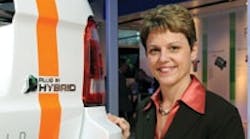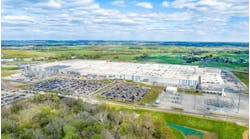Growing up in a suburb of Cleveland, one of the constants in Kevin Czinger's life was a backyard full of cars. His brother Chris was a Chevy mechanic and there was a steady stream of "outside the garage" auto repair going on, not to mention hot rodding of a '67 Barracuda and a '66 Chevelle that became a home for a big-block 454 engine. Says Czinger, "Growing up, I was non-stop involved in working on cars and building cars."
Today, Czinger's life is again focused on cars, but very different ones, for he is one of many manufacturers around the world attempting to take the automotive industry back to its roots and reintroduce the electric car as a viable, if not dominant, technology. Czinger's company CODA Automotive, based in Santa Monica, Calif., plans to begin selling a battery electric vehicle (BEV) in the fourth quarter of this year. The car can be driven 100 miles between charges and is expected to sell for $30,000 to $35,000, after tax credits.
Electric-car proponents say the technology is vital to reducing both the United States' dependence on foreign oil and greenhouse gas emissions. "We cannot be 97% dependent upon one global fungible commodity for the movement of people and goods in this country, says Brian Wynne, president of the Electric Drive Transportation Association. "It is very risky. If you add the environmental risk, it is a very compelling reason to change."
Widespread adoption of electric cars would have the twin benefits of using domestic electric production and domestic fuels while saving consumers money in the bargain, Wynne says. "Most people's cars are sitting in the driveway all night when the grid is largely underutilized," he says. "That is an enormous opportunity to fuel cars from domestic feedstock at a cost that is far less than even current prices. The typical vehicle will cost 14 cents a mile, while an electric is 2 to 3 cents." Wynne adds that smart technologies will allow cars to begin charging automatically when the local utility's electricity feed reaches a price point set by the consumer.
The Obama administration is promoting adoption of electric cars as part of its campaign to improve U.S. energy security and grow green jobs. The administration has set a target of putting 1 million plug-in hybrid vehicles on the road by 2015. The Department of Energy is offering $2 billion in grants for the manufacturing of batteries and related components.
Nancy Gioia: Ford expects 10% to 25% of its new-vehicle fleet to be electrified by 2020.
Ford's Electrification Strategy
Despite the political enthusiasm for electric cars, the path forward is full of significant technology and infrastructure challenges, not to mention a variety of consumer issues. For nearly 100 years, automotive manufacturers lived with a predictable powertrain choice the internal combustion engine. Now, many of them are hedging their bets as they try to determine which alternative fuel technology will gain wide acceptance.
For example, Ford Motor Co. has development teams working on three technologies -- hybrids, plug-in hybrids and battery electric vehicles (BEV). Nancy Gioia, director of global electrification for Ford, explains that each of them offers advantages for consumers. Hybrids offer a boost in fuel efficiency and no charging, so they require no change in consumers' behavior or in the transportation infrastructure.
A battery electric vehicle, such as the Focus electric model that Ford will introduce in 2011, has no engine or fuel tank and emits zero emissions. She promises the car will be "peppy, fun to drive and engaging." But Gioia acknowledges that BEVs have some drawbacks. They must be charged, which she says means "you have to have some way to access a 240-volt charge system so that you can charge overnight." They are entirely powered by a battery pack, which is expensive and limits the car's range to about 100 miles.
In between these technologies is Ford's plug-in hybrid, which provide about 30 miles of battery-powered driving before the gasoline engine takes over. "If I do a lot of short-distance driving during the week but I have one vehicle and on the weekends I have to go more of a distance or have more flexibility, the plug-in hybrid is perfect -- no range limitation," says Gioia, who adds that Ford will introduce a plug-in hybrid in 2012.
To help alleviate the cost of pursuing these different technologies, Ford is sharing parts between the vehicles where possible. "All of the parts are shared between the plug-in hybrid and our hybrid system except the battery. More specifically on the battery, the battery cells are different and the physical pack is different, but the battery management system, control software and hardware, thermal management methodology -- even that is shared," she explains. "Transaxles, motors, power electronics, wiring connectors -- all of those are common."
Gioia says Ford also is working to drive down costs by putting these three technologies on its highest volume platforms -- its C platform (vehicles such as the Escape, Focus, Transit Connect) and C/D platform (Fusion, Milan and, in Europe, the Mondeo). Ford produces more than 2 million units annually on each platform.
Ford is also managing costs by producing both internal combustion and electrified vehicles on the same production lines. For example, at Ford's Michigan assembly site, it will produce the Focus later this year, joined by the Focus electric in 2011 and then a hybrid and plug-in hybrid vehicle in 2012. By operating this way, says Gioia, Ford "can flex the assembly very easily, keep people employed, keep the line running at appropriate capacity and keep our supply base stable while we figure out where this is going to go."
Convincing the Consumer
While electric cars offer exciting possibilities, they are still a developing technology, which means costs are high and capabilities limited. As a result, veteran automotive industry observers such as Jack Nerad of Kelley Blue Book are skeptical about the mass appeal of electric cars. "The reality is there is no consumer demand of any appreciable volume for any of this. Everyone seems pretty satisfied with conventional vehicles," says Nerad.
Craig Giffi, a vice chairman of Deloitte and its automotive sector leader, cites research by Deloitte that estimates that the U.S. market for battery electric vehicles will be less than 1 million units annually by 2020. Deloitte identified six barriers to adoption of electric vehicles by consumers. The first is familiarity, or lack thereof, with what they are buying. The second is the credibility of the brands with consumers.
"The third barrier, the big one in consumers' minds, is the range of the vehicles," says Giffi., who notes that 70% of the consumers surveyed said they expect an electric car to travel 300 miles. While data supports 85% of consumers travel less than 100 miles daily and 70% travel less than 50 miles, they still want the vehicle to perform in a way similar to what an internal combustion vehicle will do on a tank of gas.
The fourth barrier identified in the Deloitte research is the charging infrastructure -- where owners will charge their vehicles and how long it will take to charge it. In Deloitte' survey, only 17% said they were willing to recharge from home if it takes eight hours. That number doubled to 34% for a four-hour charge time.
The fifth barrier is the general infrastructure to support electric vehicles -- where and how to charge, maintain and dispose of the vehicles.
The final barrier is price. "The real question is how committed the American consumer is to green technology," says Giffi. "History has shown us they are very price-sensitive. They are not willing to pay much, if any, premium for electric vehicles." Deloitte's survey found that 73% of consumers want an electric car to cost no more than $35,000 and 32% think it should be under $24,000.
But Coda's Czinger looks at the global increase in automobile sales and sees demand for electric cars initially exceeding the supply. Combine well-engineered products with his view that future energy demand will outstrip the supply of oil and the need to curb pollution, and he sees a bright future for electric cars.
See Also




